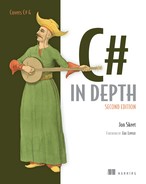Part 4. C# 4: Playing Nicely with Others
C# 4 is a funny beast. It doesn’t have the “several, almost unrelated, major new features” feeling of C# 2, nor the “all in the cause of LINQ” feeling of C# 3. Instead, the new features of C# 4 fall somewhere between the two. Interoperability is a major theme, but equally many of the features are useful even if you never need to work with other environments.
My personal favorite features from C# 4 are optional parameters and named arguments. They’re relatively simple, but can be put to good use in many places, improving the readability of code and generally making life more pleasant. Do you waste time working out which argument means what? Put some names on them. Are you tired of writing endless overloads to avoid callers having to specify everything? Make some parameters optional.
If you work with COM, C# 4 will be a breath of fresh air for you. To start with, the features I just described make some APIs much simpler to work with, where the component designers have pretty much assumed that you’ll be working with a language supporting optional parameters and named arguments. Beyond that there’s a better deployment story, support for named indexers, and a helpful shortcut to avoid having to pass arguments by reference everywhere. The biggest feature of C# 4—dynamic typing—also makes COM integration easier.
We’ll look at all of these areas in chapter 13, along with the brain-busting topic of generic variance applied to interfaces and delegates. Don’t worry: we’ll take that reasonably slowly, and the best part is that most of the time you don’t need to know the details... it just makes code work where you might’ve expected it to in C# 3 anyway!
Chapter 14 covers dynamic typing and the Dynamic Language Runtime (DLR). This is an enormous topic; I’ve concentrated on how the C# language implements dynamic typing, but we’ll also look at a few examples of interoperating with dynamic languages such as IronPython, and provide examples of how a type can dynamically respond to method calls, property accesses, and so on. It’s worth applying a little perspective here: the fact that this is a major feature doesn’t mean that you should expect to see dynamic expressions cropping up all over your codebase. This won’t be as pervasive as LINQ, for example—but when you do want dynamic typing, you’ll find it well-implemented in C# 4.
Chapter 15 takes us in a slightly different direction; Code Contracts aren’t implemented as a language feature of C# 4, but they still change how idiomatic C# 4 may be written. The core types used by Code Contracts are part of .NET 4, but they do little by themselves: the supporting tools really make the contracts come alive. Applying contracts to your code—in terms of preconditions, postconditions, assertions, and invariants—allows you to express elements of behavior that previously would’ve been left to documentation. How far you take Code Contracts is up to you, but it’s one of the most exciting and potentially cross-cutting pieces of technology in .NET 4.
